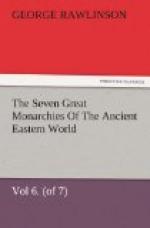After a king was once elected and firmly fixed upon the throne, his power appears to have been nearly despotic. At any rate he could put to death without trial whomsoever he chose; and adult members of the Royal House, who provoked the reigning monarch’s jealousy, were constantly so treated. Probably it would have been more dangerous to arouse the fears of the “Sophi” and “Magi.” The latter especially were a powerful body, consisting of an organized hierarchy, which had come down from ancient times, and was feared and venerated by all classes of the people. Their numbers at the close of the Empire, counting adult males only, are reckoned at eighty thousand;’ they possessed considerable tracts of fertile land, and were the sole inhabitants of many large towns or villages, which they were permitted to govern as they pleased. The arbitrary power of the monarchs must, in practice, have been largely checked by the privileges of this numerous priestly caste, of which it would seem that in later times they became jealous, thereby preparing the way for their own downfall.
The dominion of the Parthians over the conquered provinces was maintained by reverting to the system which had prevailed generally through the East before the accession of the Persians to power, and establishing in the various countries either viceroys, holding office for life, or sometimes dependent dynasties of kings. In either case, the rulers, so long as they paid tribute regularly to the Parthian monarchs and aided them in their wars, were allowed to govern the people beneath their sway at their pleasure. Among monarchs, in the higher sense of the term, may be enumerated the kings of Persia, Elymaiis, Adiabene, Osrhoene, and of Armenia and Media Atropatene, when they formed, as they sometimes did, portions of the Parthian Empire. The viceroys, who governed the other provinces, bore the title of Vitaxae, and were fourteen or fifteen in number. The remark has been made by the historian Gibbon that the system thus established “exhibited under other names a lively image of the feudal system which has since prevailed in Europe.” The comparison is of some value, but, like most historical parallels, it is inexact, the points of difference between the Parthian and the feudal system being probably more numerous than those of resemblance, but the points of resemblance being very main points, not fewer in number, and striking.
It was with special reference to the system thus established that the Parthian monarchs took the title of “King of Kings”, so frequent upon their coins, which seems sometimes to have been exchanged for what was regarded as an equivalent phrase, “Satrap of Satraps”. This title seems to appear first on the coins of Mithridates I.




